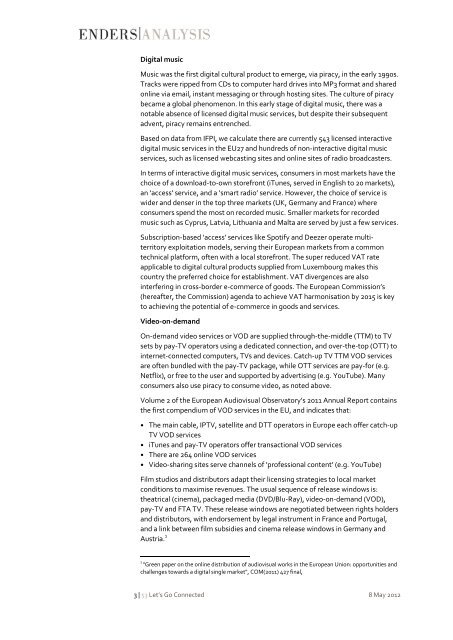Digital Europe: Diversity and Opportunity - Let's Go Connected
Digital Europe: Diversity and Opportunity - Let's Go Connected
Digital Europe: Diversity and Opportunity - Let's Go Connected
- No tags were found...
You also want an ePaper? Increase the reach of your titles
YUMPU automatically turns print PDFs into web optimized ePapers that Google loves.
<strong>Digital</strong> musicMusic was the first digital cultural product to emerge, via piracy, in the early 1990s.Tracks were ripped from CDs to computer hard drives into MP3 format <strong>and</strong> sharedonline via email, instant messaging or through hosting sites. The culture of piracybecame a global phenomenon. In this early stage of digital music, there was anotable absence of licensed digital music services, but despite their subsequentadvent, piracy remains entrenched.Based on data from IFPI, we calculate there are currently 543 licensed interactivedigital music services in the EU27 <strong>and</strong> hundreds of non-interactive digital musicservices, such as licensed webcasting sites <strong>and</strong> online sites of radio broadcasters.In terms of interactive digital music services, consumers in most markets have thechoice of a download-to-own storefront (iTunes, served in English to 20 markets),an ‘access’ service, <strong>and</strong> a ‘smart radio’ service. However, the choice of service iswider <strong>and</strong> denser in the top three markets (UK, Germany <strong>and</strong> France) whereconsumers spend the most on recorded music. Smaller markets for recordedmusic such as Cyprus, Latvia, Lithuania <strong>and</strong> Malta are served by just a few services.Subscription-based ‘access’ services like Spotify <strong>and</strong> Deezer operate multiterritoryexploitation models, serving their <strong>Europe</strong>an markets from a commontechnical platform, often with a local storefront. The super reduced VAT rateapplicable to digital cultural products supplied from Luxembourg makes thiscountry the preferred choice for establishment. VAT divergences are alsointerfering in cross-border e-commerce of goods. The <strong>Europe</strong>an Commission’s(hereafter, the Commission) agenda to achieve VAT harmonisation by 2015 is keyto achieving the potential of e-commerce in goods <strong>and</strong> services.Video-on-dem<strong>and</strong>On-dem<strong>and</strong> video services or VOD are supplied through-the-middle (TTM) to TVsets by pay-TV operators using a dedicated connection, <strong>and</strong> over-the-top (OTT) tointernet-connected computers, TVs <strong>and</strong> devices. Catch-up TV TTM VOD servicesare often bundled with the pay-TV package, while OTT services are pay-for (e.g.Netflix), or free to the user <strong>and</strong> supported by advertising (e.g. YouTube). Manyconsumers also use piracy to consume video, as noted above.Volume 2 of the <strong>Europe</strong>an Audiovisual Observatory’s 2011 Annual Report containsthe first compendium of VOD services in the EU, <strong>and</strong> indicates that:• The main cable, IPTV, satellite <strong>and</strong> DTT operators in <strong>Europe</strong> each offer catch-upTV VOD services• iTunes <strong>and</strong> pay-TV operators offer transactional VOD services• There are 264 online VOD services• Video-sharing sites serve channels of ‘professional content’ (e.g. YouTube)Film studios <strong>and</strong> distributors adapt their licensing strategies to local marketconditions to maximise revenues. The usual sequence of release windows is:theatrical (cinema), packaged media (DVD/Blu-Ray), video-on-dem<strong>and</strong> (VOD),pay-TV <strong>and</strong> FTA TV. These release windows are negotiated between rights holders<strong>and</strong> distributors, with endorsement by legal instrument in France <strong>and</strong> Portugal,<strong>and</strong> a link between film subsidies <strong>and</strong> cinema release windows in Germany <strong>and</strong>Austria. 11"Green paper on the online distribution of audiovisual works in the <strong>Europe</strong>an Union: opportunities <strong>and</strong>challenges towards a digital single market", COM(2011) 427 final,3 | 53 Let’s <strong>Go</strong> <strong>Connected</strong> 8 May 2012
















